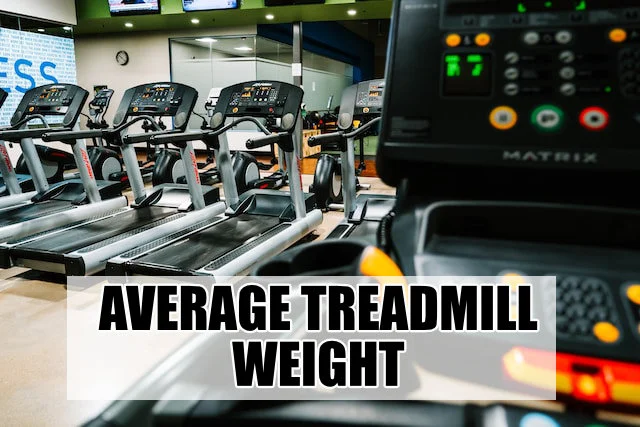“On average, home treadmills can weigh anywhere from 150 to 250 pounds.”
Welcome to the World of Treadmills
One popular piece of equipment for home gyms, and for a good reason, is the treadmill. It’s a fantastic way for seniors to maintain cardiovascular health, strength, and overall wellness.
Now, there are lots of factors to consider when adding a treadmill to your home gym, and an often overlooked one is weight. Yes, you heard it right – the weight of the treadmill itself. But why is this important? And what is the average treadmill weight for a home gym?
Over the course of this article, we’ll walk through the ins and outs of treadmills and their weight range, helping you make the best decision for your fitness journey. So lace up those sneakers and let’s dive in.
Demystifying the Treadmill: Understanding the Basics
When we talk about treadmills, the image that typically comes to mind is that of a motor-driven conveyor belt we walk or run on. Simple, right?
Well, the humble treadmill has evolved into a sophisticated machine with great features like speed adjustment, heart rate monitors, and additional features such as pre-set workout programs.
We now have different types of treadmills – manual treadmills, motorized treadmills, and hybrid. Each type has its own pros and cons, and of course, different weights.
So, as you can see, the treadmill is not just a conveyor belt in your living room. It’s a tool steeped in history, offering a wide variety of options to keep you in tip-top shape. But how does the weight factor in? Let’s delve into that next.
Weight Matters: Why Treadmill Weight is Important
You might be asking yourself, “Why on earth does the average weight of a treadmill matter?” Believe it or not, the weight of your treadmill can impact your workout and the overall functionality of your machine.
Stability and Sturdiness
Think about it – if you’re walking or running on a treadmill deck, you want it to be steady. A heavier treadmill generally equates to better stability. It’s less likely to shake or wobble while you’re using it, which in turn makes your workout safer and more effective.
Floor Health
Also, let’s not forget about the floor underneath the treadmill. Heavier treadmills distribute the user’s weight more evenly across their large frame. This distribution can reduce the risk of floor damage.
Installation and Mobility
Finally, if you’re like me, you’ll appreciate the importance of ease of installation and mobility. Heavier models can be challenging to assemble and move around. So, you’ll need to strike a balance – a treadmill that’s light enough to move when necessary but heavy enough to offer a stable workout.
I hope it’s becoming clearer why the weight of your treadmill is a critical factor in your home gym setup. So, how much do these machines typically weigh? Let’s find out!
The Scale of the Matter: Average Weight of Treadmills
When we delve into the average weight of treadmills, you might be surprised by the range. On average, home treadmills can weigh anywhere from 150 to 250 pounds. Quite hefty, huh?
The variation in treadmill weight comes down to the types and their different features:
- Folding Treadmills – As their name suggests, these treadmills can be folded up when not in use, making them space-saving champions. A foldable treadmill tends to be lighter, often weighing around 150 to 200 pounds.
- Non-Folding Treadmills – These machines are typically more substantial and robust than their folding counterparts. You might see them in commercial gyms, but they can also make a good home treadmill if you have the space. Their weight can range from 200 to 220 pounds, sometimes even more.
- Commercial-Grade Treadmills – These are the heavy-duty treadmills that you see in fitness centers. Commercial treadmills have a powerful motor and are built with advanced features and durability. They’re the heaviest treadmills often weighing over 300 pounds.
So there you have it. Treadmill weights can vary quite a bit, so it’s essential to know what you’re getting into when you buy one for your home gym. But before you make a decision, it’s a good idea to understand your home gym needs.
Making the Cut: Understanding Your Home Gym Needs
For home users choosing from the best treadmills is like picking the perfect pair of shoes – it should fit your specific needs and be comfortable to use. And with treadmills, your considerations should go beyond just cost and brand.
Space
One major consideration is the limited space you have available in your home. If you live in a smaller space or want to maximize your room, a folding treadmill could be a good option. They are lighter and often more compact, making them a great choice for tight spaces.
User Weight
Another key consideration is the user’s weight. A heavy person may need a sturdier (and therefore, heavier) treadmill. Manufacturers often list a treadmill’s maximum user weight, so always keep that in mind.
Fitness Goals
What do you want to achieve with your workouts? If you’re planning to walk or light jog, a lighter treadmill might do the job. But for those who are training for a race or want to include some serious running in their workouts, a heavier, non-folding treadmill could be a good choice.
Remember, the ultimate goal is to find a treadmill that is suitable for your personal fitness journey. Making an informed decision now can save a lot of hassle later on. Now that we’ve figured out what we need, let’s consider safety while handling this hefty piece of equipment.
Safety First: Proper Handling of Heavy Equipment
Treadmills can be bulky and heavy, and believe me, the last thing you want is to hurt yourself while moving or installing one. Here are a few tips to ensure your safety.
Be Prepared
Before you start, make sure you have all the necessary tools at hand, and you’ve read through the manufacturer’s instructions. Knowing what to expect can save you from potential injuries.
Ask for Help
When it’s time to move the treadmill, don’t hesitate to ask for help. There’s no shame in it. In fact, it’s recommended to have at least two people to safely move a treadmill.
Take Your Time
Don’t rush the process. It’s better to take your time and do it right than to hurry and risk an accident.
Follow Manufacturer Guidelines
Each treadmill is unique, so follow the manufacturer’s guidelines for the safe installation and movement of your particular machine.
Safety should always be your top priority, even when you’re just setting up your equipment. Speaking of safety, regular maintenance can also prevent accidents during workouts. Let’s explore some tips on how to care for and maintain your treadmill next.
Make it Last: Maintenance Tips for Your Treadmill
No matter how sturdy your treadmill is, it needs some TLC to stay in good shape. Regular maintenance not only increases the lifespan of your treadmill but also ensures your safety during workouts.
Clean Regularly
Dust and sweat can harm your treadmill over time. Use a damp cloth to wipe down your machine after each workout. Don’t forget to clean the deck and the area around the motor.
Lubricate the Belt
The treadmill belt needs lubrication to reduce friction between the belt and the motor. Follow the manufacturer’s guidelines on the type of lubricant to use and how often to apply it.
Check the Belt Alignment
The belt should be aligned correctly to ensure smooth operation. If the belt seems off-center, refer to your user manual for instructions on adjusting it.
Listen for Noises
Unusual noises can signal problems with your treadmill. If you notice any odd sounds, consult with a professional for a check-up.
Investing a bit of time in maintaining your treadmill can extend its life and make your workouts more enjoyable. Now, let’s focus on how to tailor your treadmill use for senior fitness.
Fit at Any Age: Tailoring Your Treadmill Use to Senior Fitness
Age doesn’t define our fitness journey; it just changes the path a bit. Treadmills can be a superb tool for seniors to stay fit, but they should be used wisely.
Start Slow
Just as with any exercise regimen, it’s essential to start slow. Don’t rush into running flat out on your new treadmill. Plan your treadmill workout to start easy and gradually build up speed and distance.
Use Safety Features
Most modern treadmills come with a safety key or clip that you can attach to your clothing. In case you slip or fall, the key will disengage, and the treadmill will stop immediately.
Pay Attention to Your Body
Always listen to your body. If you’re feeling dizzy or out of breath, slow down or stop your workout. There’s no need to push beyond your comfort zone.
Stay Hydrated
Always have a bottle of water handy while exercising. Staying hydrated is especially important for us seniors!
Treadmills can be one of the best ways for us seniors to stay fit, provided we use them safely and effectively. And with that, we’re almost at the finish line of our treadmill journey.
Stepping Forward to Fitness
Well, there you have it, folks – your ultimate guide to understanding the weight of treadmills for a home gym. It’s an often overlooked factor, but as we’ve learned, it can significantly influence the functionality, safety, and longevity of your machine.
Remember, setting up a home gym is not just about buying exercise equipment; it’s about creating a comfortable and safe environment to foster your health and wellness. Whether you’re considering budget treadmills or a hefty commercial-grade treadmill, the choice should be based on your personal needs, available space, and fitness goals.
As we step into our golden years, let’s not forget the golden rule of fitness – it’s never too late to start, and there’s no ‘one-size-fits-all’. Each one of us has a unique fitness journey. So, get out there (or stay in), find your perfect treadmill, and take that first step towards a healthier, happier you!
FAQs
1. What is the average weight of a home treadmill?
The average weight of a home treadmill can range from 200 to 220 pounds. However, this can vary depending on the type and features of the treadmill.
2. Why does treadmill weight matter?
The weight of a treadmill matters for several reasons, such as stability during workouts, floor health, and ease of installation and mobility. A heavier treadmill usually offers better stability but can be challenging to move and install.
3. What are the types of treadmills based on their weight?
There are primarily three types of treadmills – folding treadmills (weighing around 150 to 200 pounds), non-folding treadmills (around 200 to 220 pounds), and commercial-grade treadmills (over 300 pounds).
4. How to maintain a treadmill?
Maintaining a treadmill involves cleaning it regularly, lubricating the belt, checking the belt alignment, and listening for any unusual noises.
5. Are treadmills safe for seniors?
Yes, treadmills can be an excellent tool for senior fitness if used properly. It’s important to start slow, use safety features, pay attention to the body’s signals, and stay hydrated during workouts.
Key Takeaways
- The average weight of home treadmills ranges from 200 to 220 pounds, though this varies with the type of treadmill.
- The weight of a treadmill is important for its stability during workouts, protecting your floor, and considering its mobility and ease of installation.
- Choosing the right treadmill involves considering your available space, user weight, and fitness goals.
- Ensuring safety while handling a treadmill is paramount. Always be prepared, ask for help, take your time, and follow manufacturer guidelines.
- Regular maintenance of your treadmill extends its lifespan and ensures safer workouts. This includes cleaning, lubricating the belt, checking belt alignment, and listening for unusual noises.

